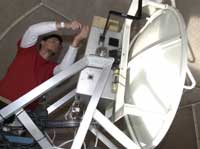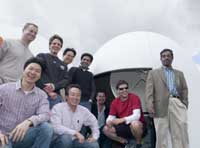The Research Angle: NSF ERC for Collaborative Adaptive Sensing of the Atmosphere Tests the Next Generation of Radars
 |
The nation's ability to monitor, anticipate and respond to dangerous weather events is becoming increasingly important as tornadoes and floods destroy more property and jeopardize more lives. However, the portion of the atmosphere that contains critical information on the bulk of these hazards, the lower troposphere, cannot be fully observed because the Earth's curvature blocks standard high-power, long-range radars.
Oklahoma's "tornado alley" is serving as a test bed for a new weather-detection system that overcomes the effects of the Earth's curvature and will lead to earlier detection of hazardous atmospheric phenomena. Colorado State University and its research partners in the National Science Foundation Engineering Research Center for Collaborative Adaptive Sensing of the Atmosphere (CASA) are designing low-power solid-state radars which are highly reliable, inexpensive and adaptive, and operate collaboratively. Scientists will have an unprecedented ability to observe the lower troposphere using an advanced system of Distributed Collaborative Adaptive Sensing (DCAS) networks designed to overcome Doppler radar limitations. This networked system enables end users to determine needs and allocate resources — such as power, frequency and bandwidth — to the regions where threats exist.
The prototype, CASA Radar 1, was designed by researchers, faculty and students from Colorado State, the University of Massachusetts at Amherst, the University of Oklahoma and the University of Puerto Rico at Mayagez. It was tested at the CSU-CHILL radar facility east of Greeley before being deployed to Oklahoma. A second test bed in Houston will monitor and predict floods more accurately and a third in Puerto Rico will improve monitoring of floods produced by thunderstorms and hurricanes over the island.
 |
|
Chandra, right, is co-principal investigator of the CSU-CHILL Radar facility where he and the CASA team built "CASA Radar 1." |
Through this partnership of universities, corporations and government agencies, CASA is demonstrating the potential for DCAS networks to revolutionize our understanding, detection and prediction of atmospheric phenomena, saving lives and property through better and earlier hazardous weather warnings.